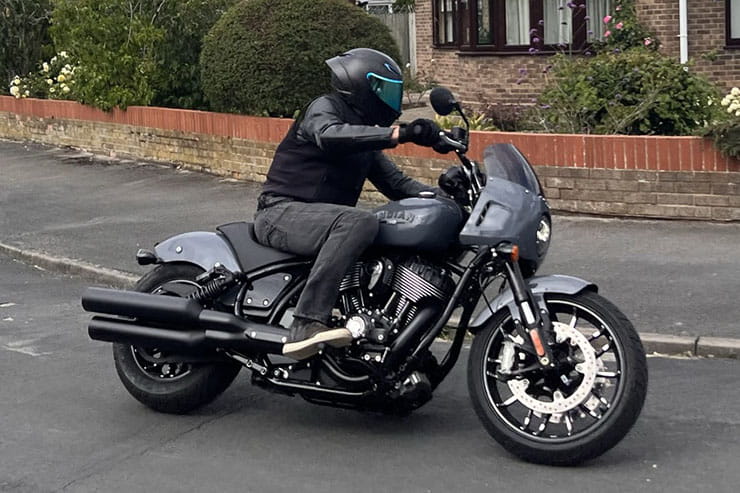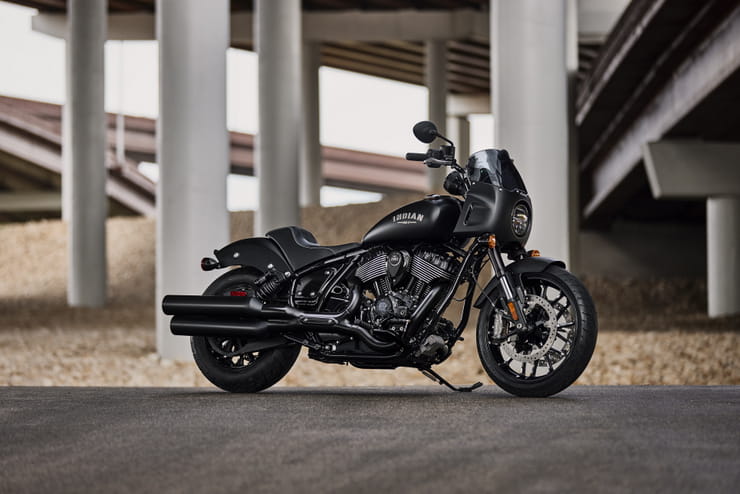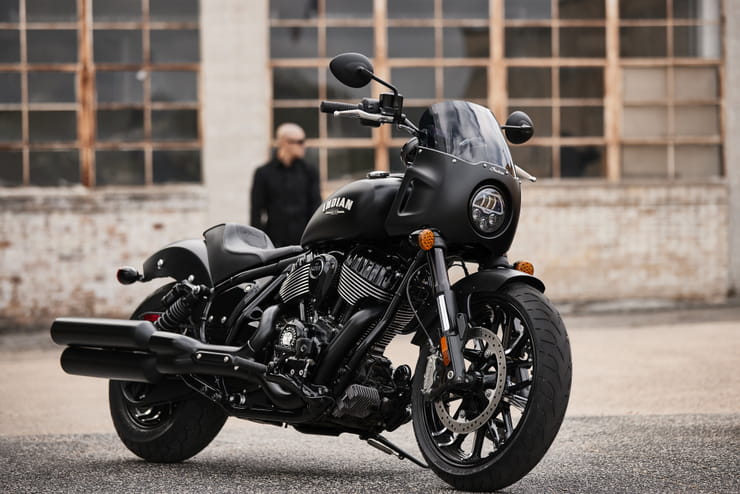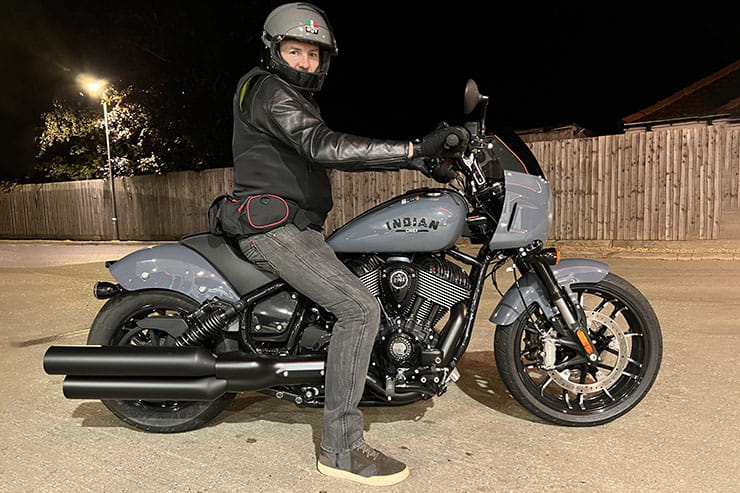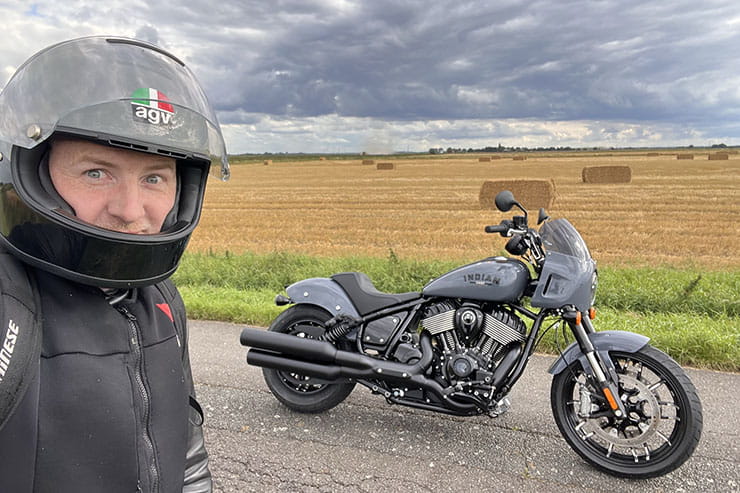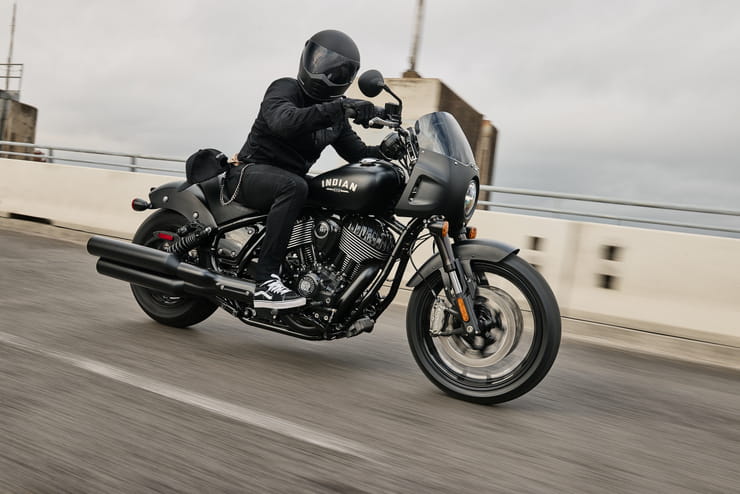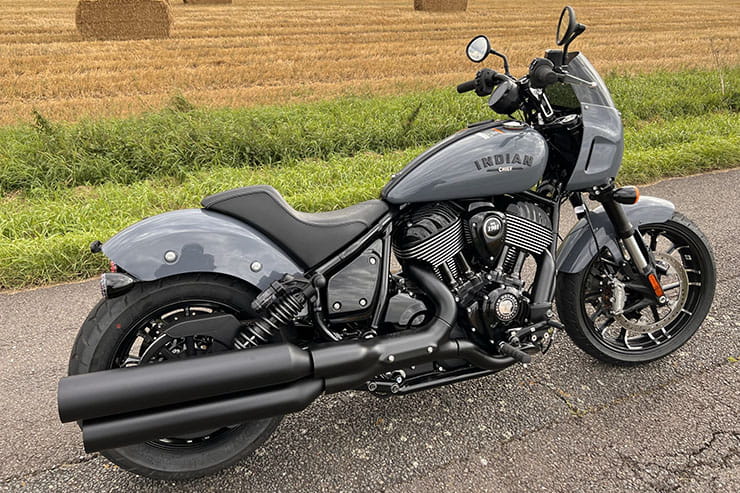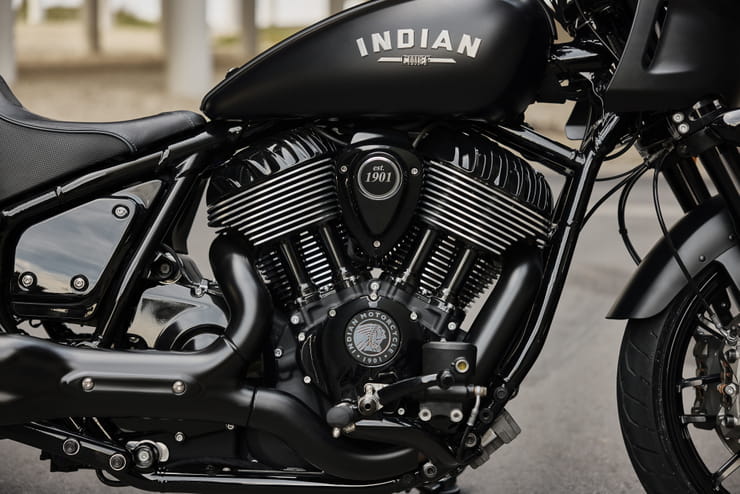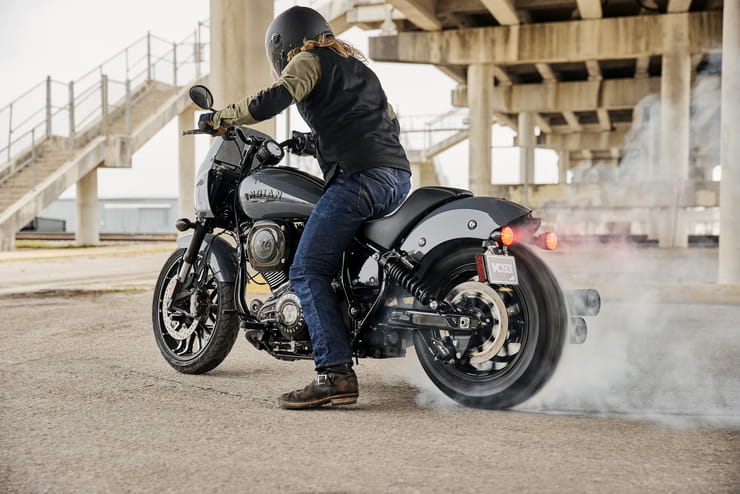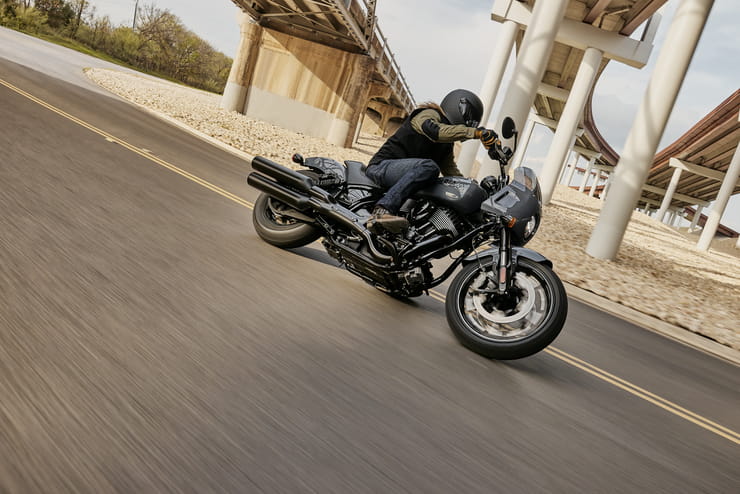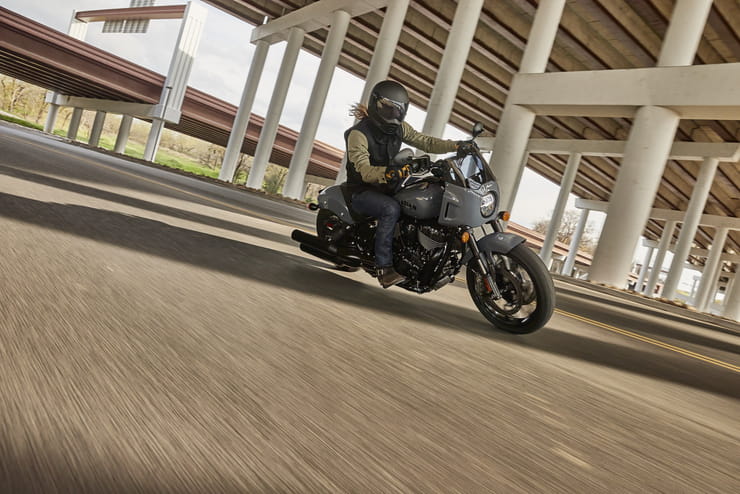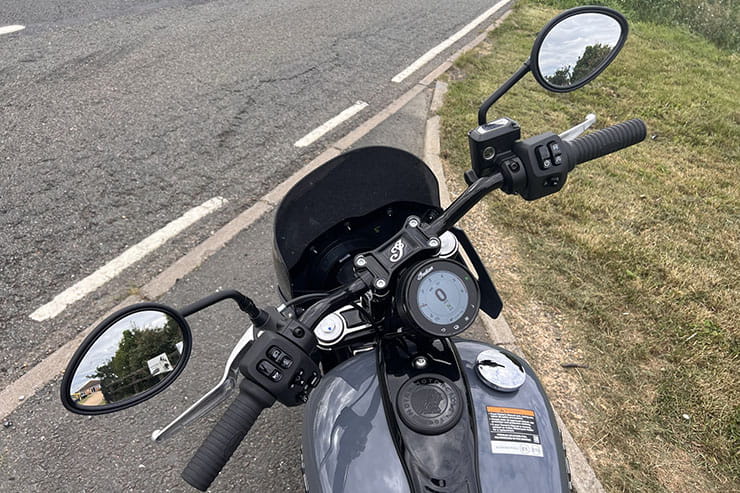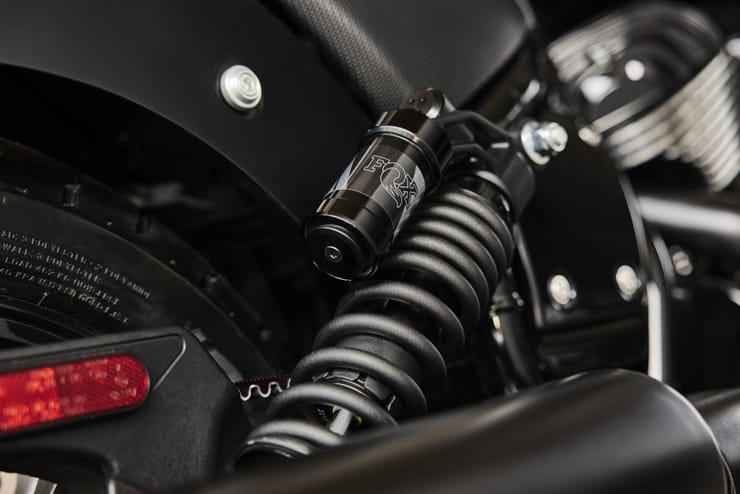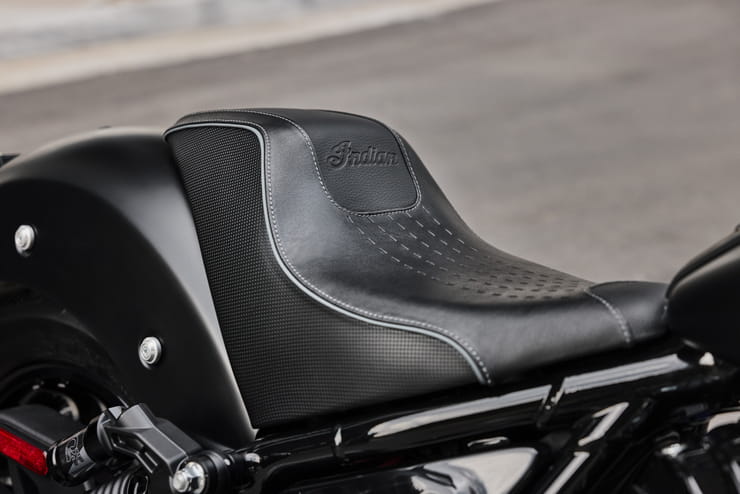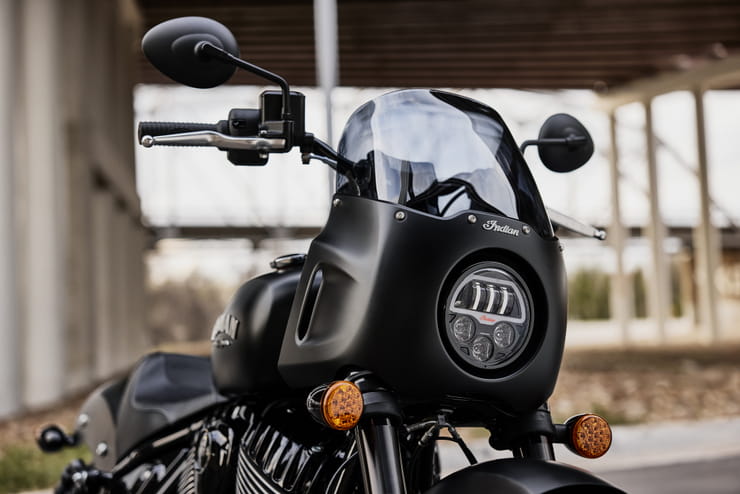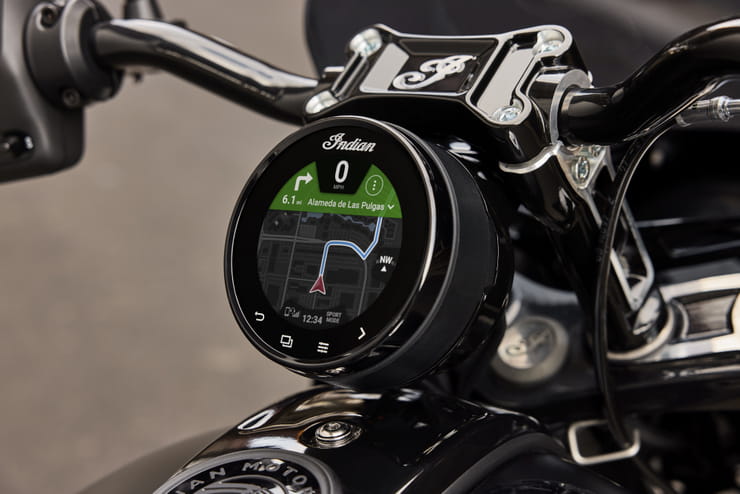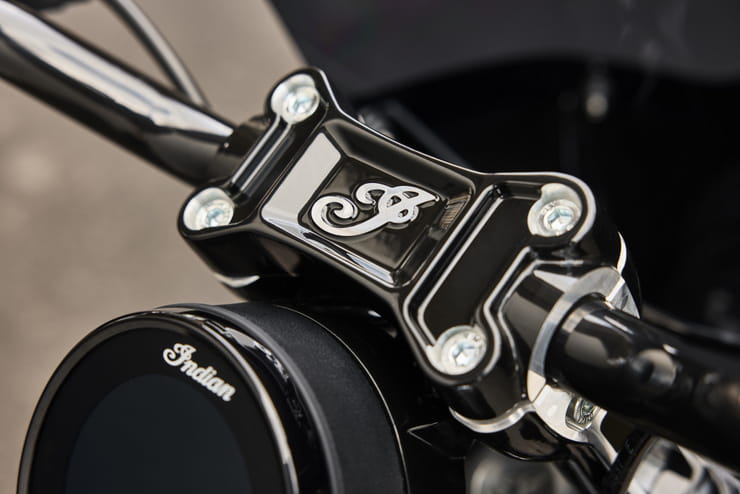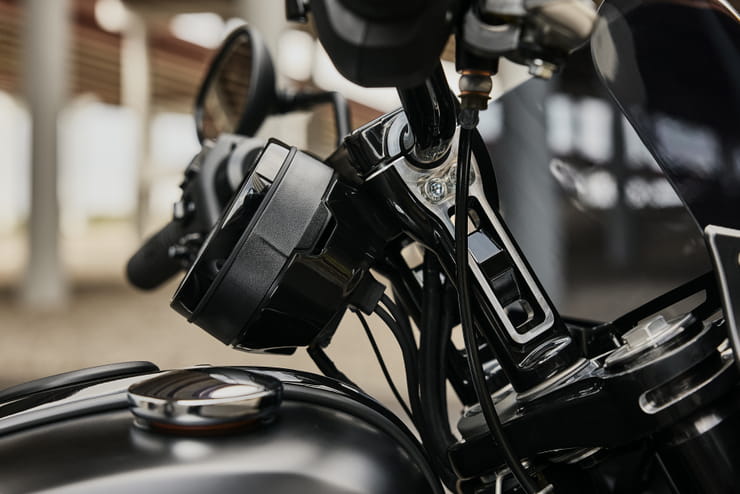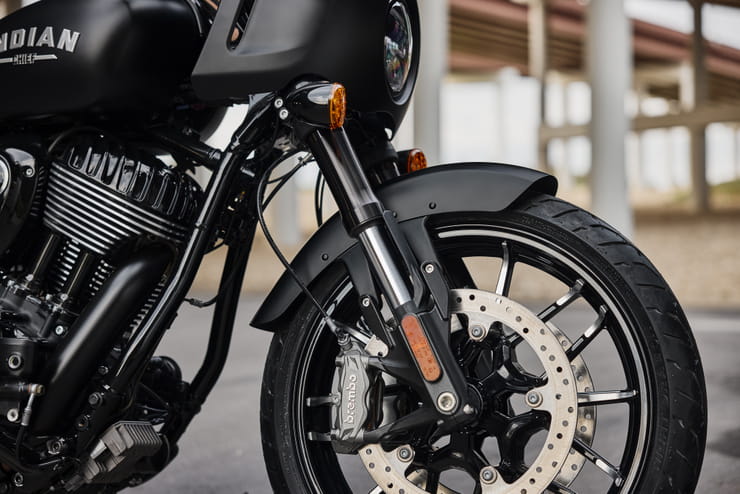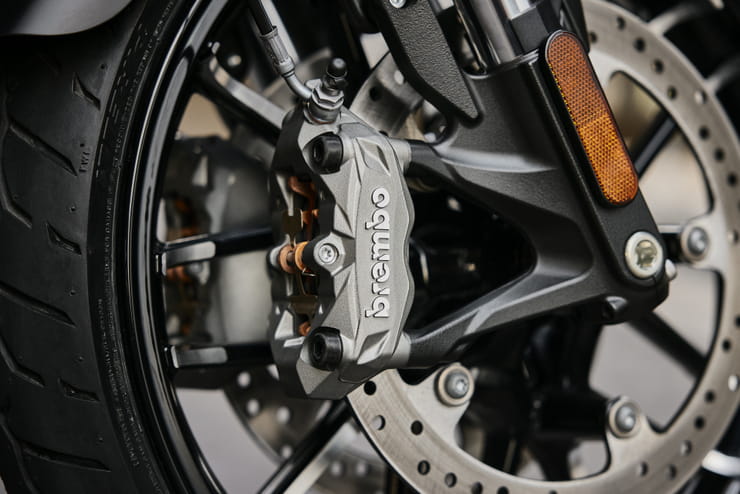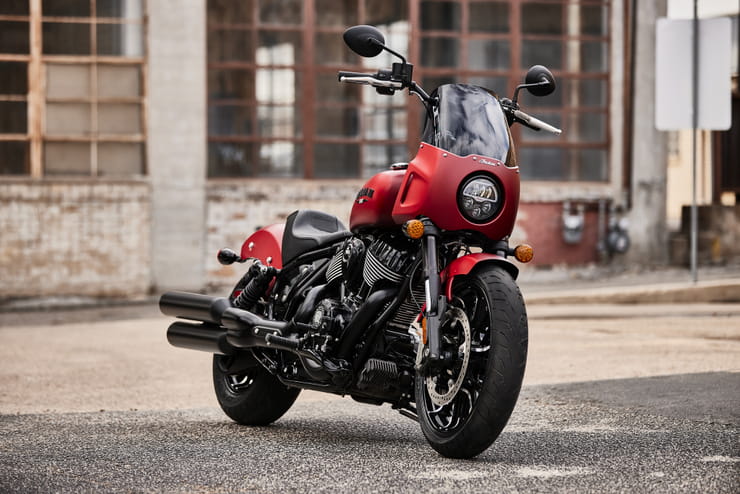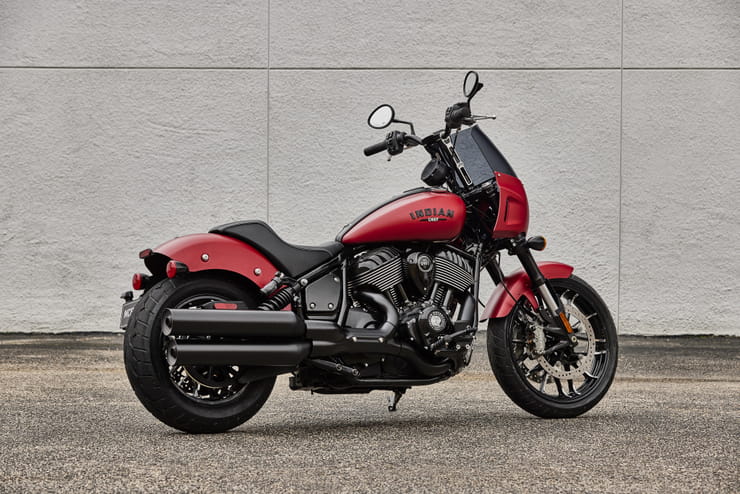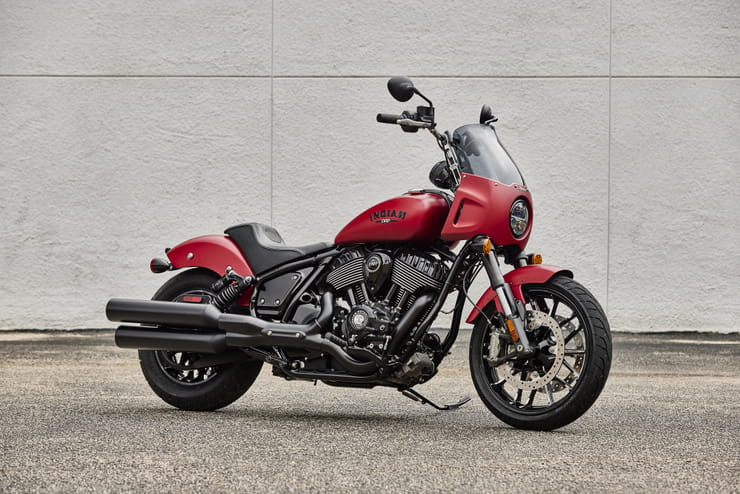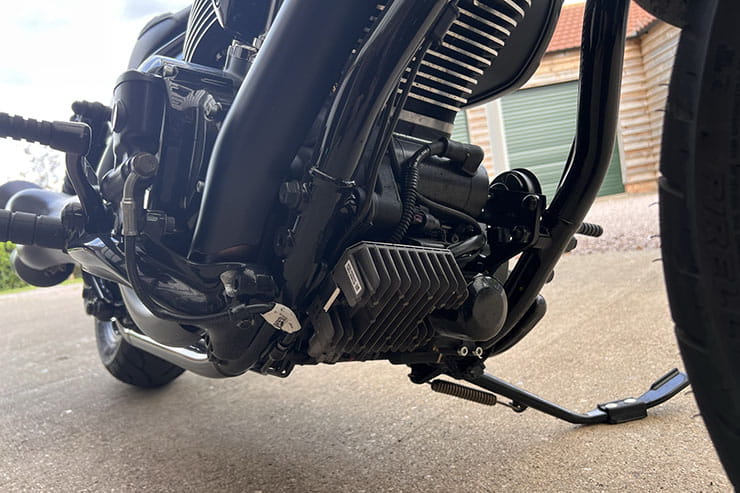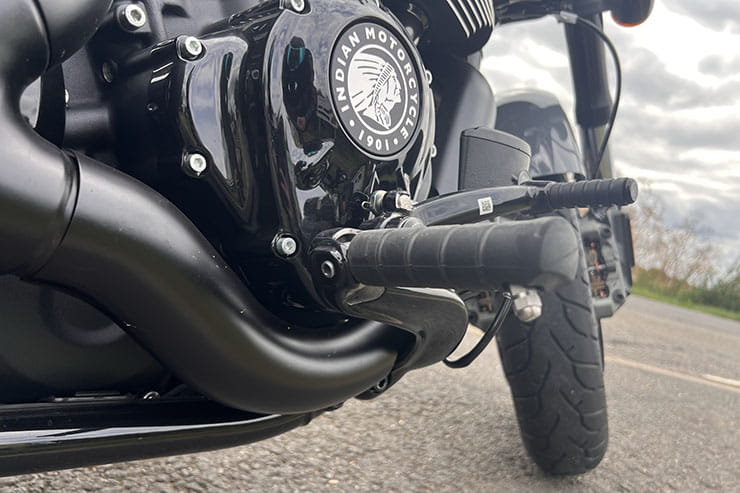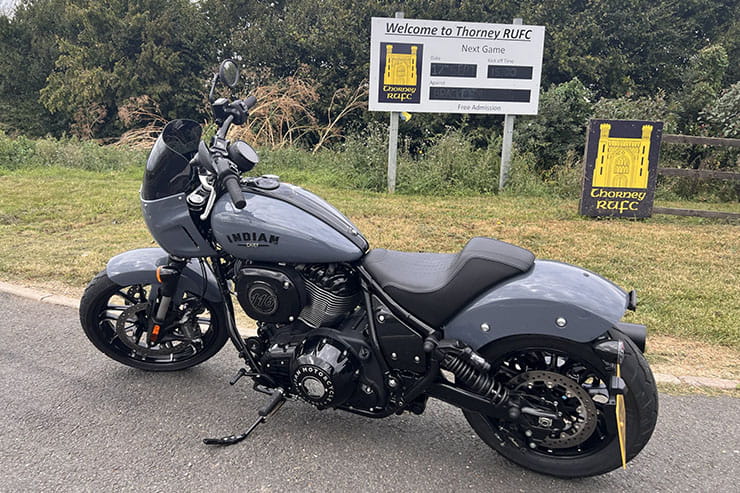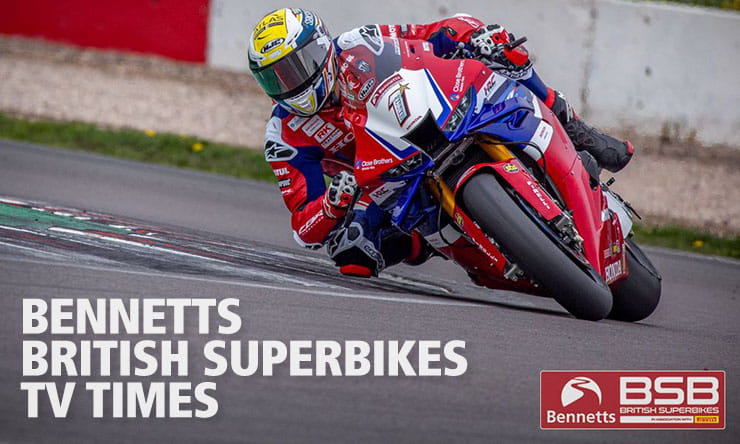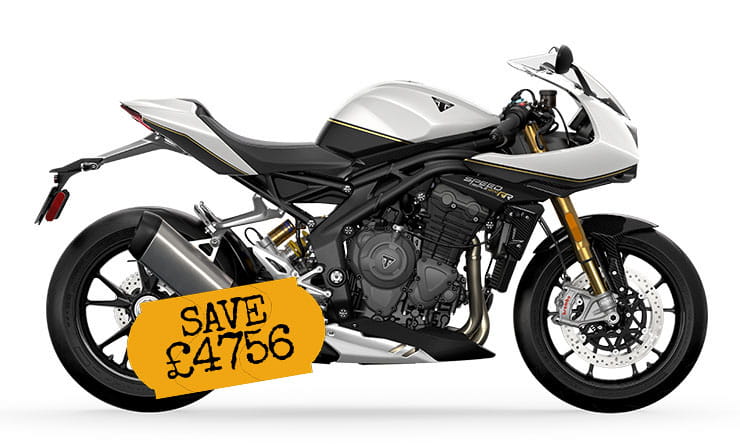Price: £19,995 | Power: 89bhp | Weight: 302kg (dry) | Overall BikeSocial Rating: 3.5/5
Technical Review: Ben Purvis (21/2/23)
Riding Review: Michael Mann (22/9/23)
The term sport cruiser might seem like an oxymoron but it’s a popular subgenre of the traditional American cruiser class – spawning machines like the Harley-Davidson Low Rider S. This is Indian’s direct competitor for that bike: the Sport Chief.
The name really explains the bike. It’s based on Indian’s 1890cc, air-cooled Chief cruiser but with an array of sportsbike-inspired components, from upside-down forks, beefy radial brakes and a nose fairing to the taller, hump-backed ‘gun-fighter’ saddle and remote-reservoir shocks.
“In 2021, we celebrated the 100-year anniversary of Indian Chief with a line-up that pays homage to the glory days of American motorcycling,” said Ola Stenegärd, Director or Industrial Design for Indian Motorcycle, “With Sport Chief, we wanted to maintain the same care-free attitude and American muscle but elevate it even further with componentry that not only delivers a style and attitude that exudes performance, but raises the bar entirely for performance cruisers.”
And here it is, never has the word ‘sport’ be used to describe a heavyweight 2-litre cruiser, so BikeSocial’s Michael Mann spent 350-miles in the saddle on various trips but was he King of the Road, or Disappointed of Whittlesey?
Pros and Cons
- Much better suspension and brakes than one might expect
- Big ‘Thunderstroke 116’ V-twin suits fans of traditional, air-cooled cruisers
- Strong tech including touchscreen dash
- Less power and torque than the Harley Low Rider S
- Awful headlights
- 300kg-plus weight, so take ‘Sport’ with a pinch of salt
Review – In Detail
Price & PCP
For and against
Engine & Performance
Handling & Suspension (inc. weight & brakes)
Comfort & Economy
Equipment
Rivals
Verdict
Owner Reviews
Specification
From £19,995 and available in three colours: Black Smoke, Ruby Smoke, or Stealth Gray. The latter two increase the price to £20,495. The identically-powered Chief Dark Horse starts at £17,495 and the Sport Chief’s main rival, Harley-Davidson’s Low Rider S, costs £19,395.
I don’t expect the value of a bike like to drop too significantly, so what might appear to be an inflated investment to begin with, might just turn into a decent longer-term deal. Despite that huge price tag, pound (lb)-for-pound (£), the Sport Chief offers decent value.
Power for the Sport Chief comes from Indian’s Thunderstroke 116 V-twin, one of the remaining stalwarts of the ‘traditional’ cruiser brigade, complete with air cooling, pushrod-operated valves and a vast displacement.
The ‘116’ reflects the engine’s capacity in cubic inches, falling just a fraction shy of Harley’s biggest standard production engine, the Milwaukee-Eight 117, as used in the Low Rider S. In more familiar, metric numbers, the Indian’s engine comes in at 1890cc, while the Harley motor measures 1923cc. Big figures indeed, but not ones that are reflected in terms of outright power. Harley claims only 105hp from the Low Rider S, and Indian shies away from listing power figures for its bikes at all. Delving into type-approval documents, we find that Euro 5 versions of the Thunderstroke 116 used in other versions of the Chief are good for a peak of 89hp.
Before you scoff, there are a couple of other figures to consider – the revs at which that power arrives and the torque that accompanies it. Indian’s Thunderstroke manages its max power at a mere 4300rpm (720rpm less than the rival Harley), and its peak torque is a thumping 119lb-ft (162Nm) at only 3200rpm. The Low Rider S, by comparison, manages 124lb-ft (168Nm) at 3500rpm, reflecting its slight edge in outright capacity.
There’s tech in the Indian engine, too, despite its traditional layout. Cylinder deactivation, for instance, is used to switch off the rear cylinder while you’re idling in traffic, improving economy and reducing the heat that might otherwise threaten to cook your legs.
The engine drives through a six-speed box and a toothed belt final drive.
And in the saddle you soon realise why the designer made a seat with a back stop (‘Gunfighter’ style) – the Sport Chief accelerates hard, so while the top end horsepower figure is disappointing for those who live by spec sheets, there’s plenty of torque available to drive quickly and meaningfully from low revs – in fact at 119 lb-ft that’s more than Ducati Multistrada V4, a BMW M 1000 R, or a Kawasaki Ninja H2 SX SE even. It’s awesome, even rolling on at low revs despite hauling the 400kg (inc. rider) around – you can’t fail to grin when pinning the throttle in 2nd gear at 30mph in Sport mode! And it’s not like you need all the revs to make a real dent in the journey. The gearbox is, as cruiser riders would appreciate, heavy going but it’s also precise and once you’re familiar with the strong clutch action and how to operate the gear lever then it soon becomes the norm. Ride it too energetically and the revs quickly run out with a 5k rpm redline, and there’s a big difference in power delivery and corner exit speed from the three riding modes which are simple to swap between while on the move too.
It's a grunty, grungy, powerful soundtrack that bellows from the V-twin, empowering enough to give you those ‘King of the Road’ vibes. ‘Vibes’ as in the modern-day social term, as well as the hearty, earthy throbbing of 116 cubic inches of grrr from below.
While the Sport Chief’s engine is familiar from its sister models, the suspension is a clear step ahead of them – and Indian claims it’s the best in its class (which isn't too tricky). At the front, there’s a pair of upside-down KYB forks, 43mm in diameter, and they’re joined by a duo of Fox piggyback shocks at the back. Suspension adjustment is limited to preload, only at the rear, but Indian is also offering a set of higher-spec Fox shocks as an option, adding compression and rebound damping adjustment.
Compared to the standard Chief, the Sport Chief has more rear suspension travel (100mm, up from 75mm) and ground clearance to increase the potential lean angle to 29.5 degrees. The frame itself is slightly tweaked with 28 degrees of rake down from 29, and with 111mm of trail rather than 131.5mm.
So, the ‘bar risers and MX-style handlebars along with the back-stop seat, KYB forks, twin Fox shocks, radial Brembos are the chassis-based elements that make the Sport Chief the most athletic version in Indian’s Chief range. Those components add some ground clearance but not nearly enough to warrant the ‘Sport’ moniker because if you’d just dropped £20k and arrived at the first roundabout away from the dealership, there’s a 50/50 chance you’ll be scraping the footpegs with the sub-30-degree lean angle allowance.
If you’ve ever ridden a feet-forward cruiser or bobber then you’ll be all too familiar with an unpleasant seating position and uncompromising/lack of rear suspension. With the Sport Chief, there’s a much more pleasurable experience when swinging a leg over. The twin shocks give plenty of support and compression allowing for bumps and lumps in the road surface to be swallowed up without jarring your lower back. And it handles the swerves and curves well too, for a bit unit.
The firm has been learning from its racing success across the pond with the flat trackers, FTRs, and King of the Baggers/Challenger, and despite their respective appearances but less-than-sporty, the Sport Chief’s ability to hustle is enticing, if not wholly perfect. And that draws me to it – the Pirelli tyres are grippy, the steering is relatively light, and the brakes are strong. Yes, it’s size and geometry suggest it shouldn’t handle, but it does for a machine weighing way more than a fully loaded GS Adventure, it’s really entertaining too. It sits nicely at the rear when accelerating out of corners, and those extra kgs even assist with the grip. If you, as I did, plan on munching some motorway miles, then the cruise control is an easy-to-use option.
Worth pointing out here is the lack of weather protection from behind the front wheel – ride the Indian on anything but smooth, dry tarmac and there’s high change of filthy engine parts, or worse still, a stone wedged somewhere it shouldn’t be.
To be fair customers opting for nearly two litres of air-cooled V-twin probably don’t have economy that at the forefront of their priorities. The Thunderstroke engine is fed by a 15.1 litre tank, which means a decent range between fill-ups. I managed an indicated average of 43mpg on my time with the bike, which included shorter 10-mile office commutes and a couple of longer 120-140-mile jaunts, and indicates a full tank range of around 170-miles.
In terms of comfort, the ‘Sport’ name doesn’t mean low clip-ons and rear set pegs in this instance – the riding position of the Sport Chief is very much in the cruiser mould. The foot controls are relatively far forward, and while the bars are a straight, motocross-style design they’re mounted on tall 152mm risers to bring them up and back. Options include even bigger 254mm risers that put the bars higher still.
The upright riding position means you’ll be looking over the screen, not through it, but even so it should provide some wind protection and there are low and tall versions as options. If you want to take a passenger, there’s also the option of a dual seat and pillion backrest.
It’s worth noting that the Sport Chief’s bars, fairing and Fox rear shocks are also being made available as options for the standard Chief, Chief Bobber and Super Chief.
On-board tech includes Indian’s usual 101mm circular touchscreen dash, including navigation, phone connectivity and two gauge layouts, all operational via the old fashioned style switchgear which is supplemented, strangely, by an additional spring-loaded button hidden on the handlebar in front of each lever. It's easy to miss the indicator and flick the switch that doens't really do anything, and the whole lot isn't backlit, so don't let you first ride be in the dark.
The seating position on the Indian is unique-ish. For those who enjoy the cruiser/bobber style with weight on your coccyx and a reach for the ‘bars then this could be for you. Though unlike any others of this layout I’ve ridden, I actually felt comfortable enough for a 60+ mile trip without stopping. The feet-to-hip ratio crossed with the reach to the butch grips isn’t the most natural, you feel curled over too much with knees up near elbows as the V-Twin gently slow roasts you calfs, though I have been far less comfortable on a Triumph Bobber, for example. The seat itself is very plush and its design ideal for the type of riding the bike encourages.
The fairing doesn’t do a great deal because it’s narrow, though a taller screen is an £211 option and might be worth looking at if you’re a six-footer like me
Heated grips would be an extra £350, and if you’re looking at luggage (because there’s no space to store even a toothbrush), then a set of official saddlebags comes with a price tag north of £1300.
The 4” circular and digital touchscreen is small but perfectly formed – and very intuitive to use too. It can be operated while on the move and even offers load sof information on various screens, and can be connected via Bluetooth to your smartphone.
2023 INDIAN SPORT CHIEF brakes
While the normal Chief makes do with a single 300mm front disc the Sport Chief gets a pair of 320mm discs, each grabbed by a four-pot Brembo radial-mount caliper, while the rear features the same 300mm disc and two-piston caliper used on other models.
There’s ABS, but it’s not a clever cornering ABS setup.
But thank goodness for twin discs – after all, add this rider’s weight to the mass of the bike and add some fuel, then those Brembo’s have got near enough 400kg to slow/stop. Just like the rest of the bike, the lever is solid, sturdy, and sizeable, though not span adjustable. They work harmoniously with the non-adjustable forks to offer stability under hard braking, and all-in-all their performance must be praised.
The Indian Sport Chief’s specs are very clearly tailored to make it compete with one bike: Harley-Davidson’s Low Rider S. From the nose fairing and 43mm USD forks to the 19in/16in front and rear cast alloy wheels, it’s head-to-head against the Harley in every respect.
Harley Low Rider S
| Price: £19,395
Power/Torque: 105bhp/124lb-ft | Weight: 295kg (dry)
Ducati Diavel V4 | Price: £23,595
Power/Torque: 166bhp/93lb-ft | Weight: 234kg
The weight and seating arrangement of the ‘Sport’ Chief massively contradicts the name but get used to it and your mind simply adjusts to this rather unique proposition. Before seeing the Indian for the first time, if all you were given was the spec sheet and its name to go and create the bike, you’d be left scratching your head questioning what it’s supposed to do, and what type of customer it’s supposed to attract.
Fast forward to actually testing it and each time you ride the Sport Chief it rather momentous – it becomes easy to forgive the lack of turning circle, storage or ground clearance, its weight distribution, discomfort, price, choppy throttle at low speed in Sport mode, and I’ve not even mentioned the horrendous headlights which are so poor they verge on being dangerous. Hang on, is all that forgivable for 20-grand?
Nevertheless, it’s physical awkwardness becomes an endearing feature… and, as with most bikes I ride, I want to be noticed, I want to feel like I’m promoting motorcycling to the non-conformists, and this Indian treats those people to a glimpse of what or who they could be. We wear a helmet not to shy away and hide our face but to stand out and be seen as that cool person riding a motorbike, and the Indian most definitely makes you feel good – long live the internal combustion engine for the mind therapy it provides in the form of the Sport Chief. Despite our differences, we were good mates after 350-miles.
Oh, and keep the bike on trickle charge if you plan on not using it for more than 24 hours.
If you have a 2023 Indian Sport Chief and want to share your thoughts then get in touch via enquiries@bikesocial.co.uk
Above: those hero blobs won’t last long
|
New price
|
From £19,995
|
|
Capacity
|
1890cc
|
|
Bore x Stroke
|
103.2mm x 113mm
|
|
Engine layout
|
49-degree V-twin
|
|
Engine details
|
2-valve, air-cooled, pushrods, cylinder deactivation
|
|
Power
|
66.5kW (89hp) at 4300rpm
|
|
Torque
|
162Nm (119 lb-ft) at 3200rpm
|
|
Transmission
|
6 speed, belt final drive
|
|
Average fuel consumption
|
43mpg
|
|
Tank size
|
15.1 litres
|
|
Max range to empty
|
c.170 miles
|
|
Rider aids
|
ABS
|
|
Frame
|
Steel tube frame, cast aluminium subframe
|
|
Front suspension
|
43mm KYB inverted forks
|
|
Front suspension adjustment
|
N/A
|
|
Rear suspension
|
Twin Fox piggyback shocks
|
|
Rear suspension adjustment
|
Preload only (compression and rebound adjustment optional)
|
|
Front brake
|
2 x 320mm discs, 4-piston Brembo radial calipers
|
|
Rear brake
|
300mm disc, 2-piston caliper
|
|
Front wheel / tyre
|
Pirelli Night Dragon 130/60B19 61H
|
|
Rear wheel / tyre
|
Pirelli Night Dragon 180/65 B16 81H
|
|
Dimensions (LxWxH)
|
TBA
|
|
Wheelbase
|
1640mm
|
|
Seat height
|
686mm
|
|
Weight
|
302kg (dry)
|
|
Warranty
|
24 months, unlimited mileage
|
|
Servicing
|
500 miles, then every 2,500 with a major service at 10,000
|
|
MCIA Secured Rating
|
Not yet rated
|
|
Website
|
www.indianmotorcycle.co.uk
|
If you’d like to chat about this article or anything else biking related, join us and thousands of other riders at the Bennetts BikeSocial Facebook group.
Looking for motorcycle insurance? Get a quote for this motorbike with Bennetts bike insurance
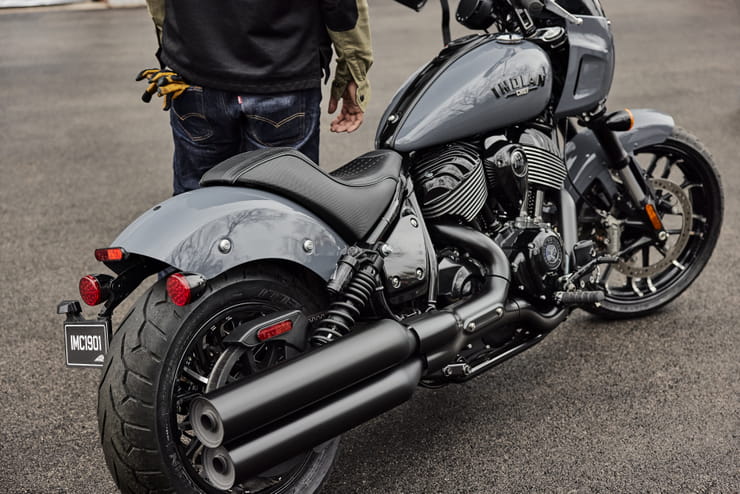
What is MCIA Secured?
MCIA Secured gives bike buyers the chance to see just how much work a manufacturer has put into making their new investment as resistant to theft as possible.
As we all know, the more security you use, the less chance there is of your bike being stolen. In fact, based on research by Bennetts, using a disc lock makes your machine three times less likely to be stolen, while heavy duty kit can make it less likely to be stolen than a car. For reviews of the best security products, click here.
MCIA Secured gives motorcycles a rating out of five stars (three stars for bikes of 125cc or less), based on the following being fitted to a new bike as standard:
- A steering lock that meets the UNECE 62 standard
- An ignition immobiliser system
- A vehicle marking system
- An alarm system
- A vehicle tracking system with subscription
The higher the star rating, the better the security, so always ask your dealer what rating your bike has and compare it to other machines on your shortlist.



